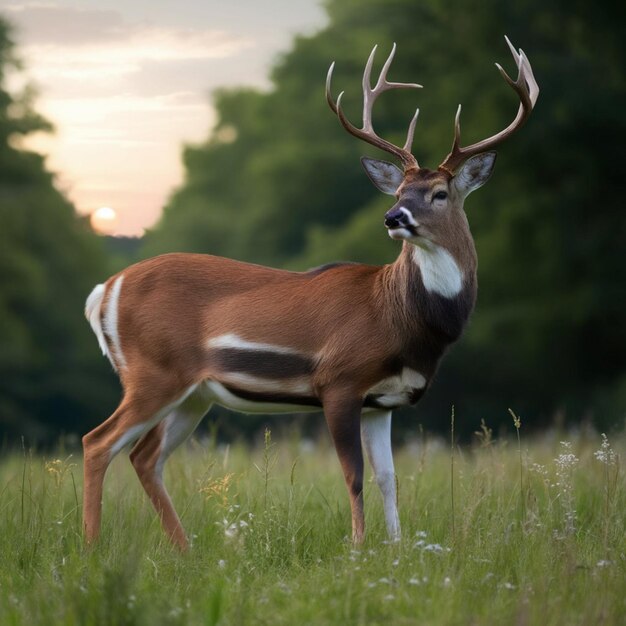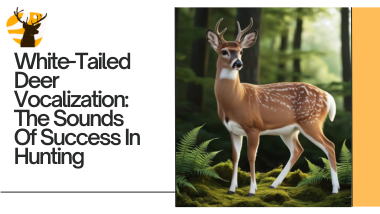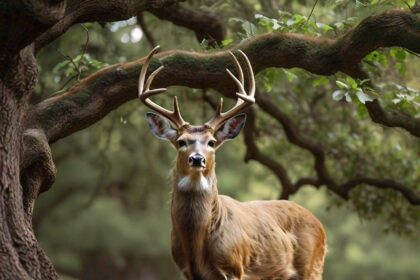
Do you know that a single grunt from a white-tailed buck can travel over 100 yards in the forest, signalling dominance and attracting mates?
Understanding white-tailed deer vocalization is crucial for hunting enthusiasts aiming for success in the field. These sounds can provide insights into deer behavior, helping you make informed decisions.
White-tailed deer, known for their grace and adaptability, are a favorite among hunters across North America. Their communication plays a crucial role, especially during the breeding season.
This article will unveil the different types of sounds that white-tailed deer make, their meanings, and how individuals can use this knowledge to enhance their hunting experience.
Understanding Deer Vocalizations
White-tailed deer communicate through a variety of sounds. Each sound serves a specific purpose and is essential for both social interaction and mating behaviors. Here are the primary types of deer sounds :
Grunts
Grunts are the most recognized sound that deer make, especially among whitetail bucks. They can vary in tone and intensity but generally fall into three categories:
- Basic Grunt: A low, soft call used by bucks to communicate their presence.
- Trailing Grunt: A series of short grunts made by a buck as he follows a doe’s scent.
- Tending Grunt: A deeper grunt made by bucks when they are close to a receptive doe.
You can use grunt calls effectively during the rut to attract nearby bucks. For instance, using a trailing grunt can mimic a buck following a doe, enticing other bucks in the area to investigate.
Bleats
Bleats are primarily produced by dogs and fawns. This higher-pitched sound serves several purposes:
- Mother-Offspring Communication: Does use bleats to call their fawns back to them.
- Mating Signals and communication strategies in wildlife.: During the rut, does may bleat to signal their readiness to mate.
The bleat is an excellent call for individuals to mimic when trying to attract both ‘does’ and bucks. A well-timed bleat can draw in curious deer, making it an invaluable tool during hunting seasons for whitetail bucks.
Snorts
Snorts are sharp exhalations through the nostrils that serve as alarm signals. When a deer senses danger, it will snort to alert others in the area.
This often indicates that something might be amiss and is often followed by fleeing behavior.
For people interested in deer hunting, recognizing snorts can be crucial. If you hear a snort while on this adventure, it’s best to remain still and quiet; sometimes, deer will return once they feel safe again.
Wheezes
Wheezes are aggressive sounds made primarily by bucks when they are challenging one another. This often indicates that a confrontation is imminent, as seen in various animal interactions.
Hearing a wheeze can signal that dominant bucks are nearby, providing deer hunting enthusiasts with an opportunity to make their move while the bucks are distracted.
Unique Aspects of White-Tailed Deer Vocalization
Whitetail deer vocal sounds, like grunts and bleats, are not only interesting but also unique compared to other animal species.
1. Diverse Vocalizations
White-tailed deer have an extensive range of vocalizations, with researchers identifying between 200 and 400 different sounds they can make.
These vocalizations include grunts, bleats, snorts, and wheezes, each serving distinct purposes.
For instance, while grunts are often associated with communication among bucks during the rut, bleats are primarily used by does to call their fawns or signal readiness to mate.
Understanding this diversity allows hunters to select the right call at the right time, increasing their chances of attracting deer.
2. Contextual Meaning
The meaning of each sound varies significantly based on context. For example, a buck’s grunt can indicate everything from casual social interaction to a serious challenge for dominance during the mating season.
Similarly, a doe’s bleat can signal distress or serve as an invitation for nearby bucks. This contextual understanding is crucial for hunters; knowing when to use a specific call can mean the difference between success and failure in the field.
3. Physical Changes Influence Vocalization
During the breeding season, physical changes in bucks affect their vocalizations. As testosterone levels rise, bucks develop larger necks and deeper grunts.
This change in vocal quality can help hunters distinguish between different deer and their intentions.
For example, a deeper tending grunt indicates a buck is actively pursuing a doe, signaling that he may be more susceptible to calls mimicking this behavior.
4. Social Dynamics and Hierarchies
Vocalizations play a significant role in establishing social dynamics among deer. Bucks use grunts to communicate their status within a hierarchy, while does may use bleats to maintain contact with their fawns or signal others in the area.
Understanding these social cues can help hunters predict deer movements and behavior during different phases of the rut.
For instance, if you hear aggressive snorts or wheezes, it may indicate that dominant bucks are asserting themselves nearby, presenting an opportunity for hunters.
5. Differences Between Species
While white-tailed deer vocalizations are rich and varied, they differ from those of other species like black-tailed deer. Black-tailed deer tend to be less vocal overall and rely more on body language and scent marking for communication.
This distinction is essential for hunters who may encounter both species; knowing how to interpret these sounds can help tailor hunting strategies effectively.
Refer to this youtube video for more whitetail deer sounds
White-Tailed Deer vs. Black-Tailed Deer Vocals
While both white-tailed and black-tailed deer use similar types of communications, there are notable differences between them:
| Features | White-Tailed Deer | Black-Tailed |
| Vocalizations Frequency | More frequent during rut | Less frequent overall |
| Communication Style | Uses grunts, bleats, and snort-wheeze extensively. | Relies more on body language and less on vocal sounds like those of a whitetail buck |
| Habitat Influence on deer call effectiveness | Dense habitats encourage vocal use | More open habitats reduce the need for deer calls |
White-tailed deer are more likely to respond to calls compared to black-tailed deer, which may require visual tactics like decoys or movement-based approaches.
To wrap up,
Understanding white-tailed deer vocalization is not just an academic exercise; it’s a critical skill for any serious hunter.
These actions provide valuable insights into deer behavior, allowing you to predict movements and make strategic decisions in the field.
From the assertive grunt of a buck to the alarming snort of a doe, each sound carries meaning that can greatly enhance your chances of success.
By mastering these communication mediums and knowing when to use them, you’ll be better equipped for your next hunting adventure in the wild.
Ready to elevate your career? Explore more tips and resources on our website or subscribe for updates on wildlife communication! For further learning on this topic, check out this YouTube video that breaks down various deer sounds and how you can effectively use them








